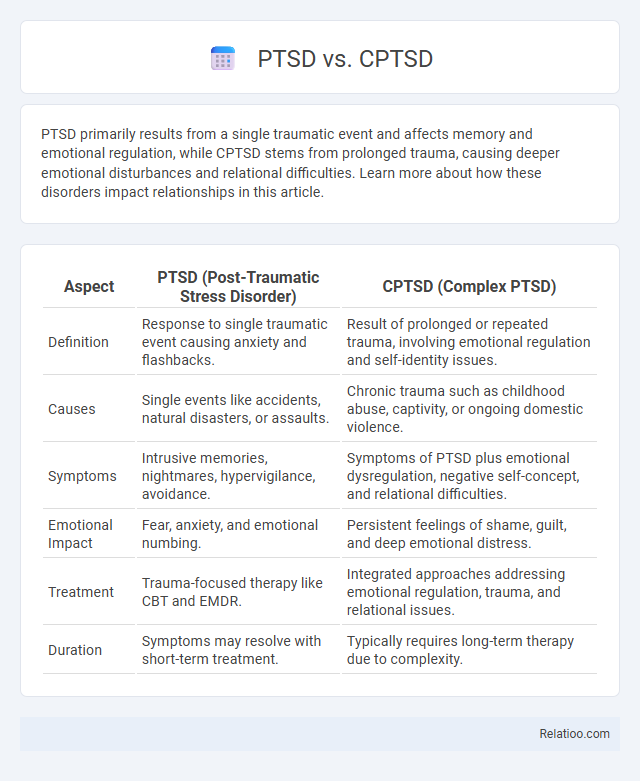PTSD primarily results from a single traumatic event and affects memory and emotional regulation, while CPTSD stems from prolonged trauma, causing deeper emotional disturbances and relational difficulties. Learn more about how these disorders impact relationships in this article.
Table of Comparison
| Aspect | PTSD (Post-Traumatic Stress Disorder) | CPTSD (Complex PTSD) |
|---|---|---|
| Definition | Response to single traumatic event causing anxiety and flashbacks. | Result of prolonged or repeated trauma, involving emotional regulation and self-identity issues. |
| Causes | Single events like accidents, natural disasters, or assaults. | Chronic trauma such as childhood abuse, captivity, or ongoing domestic violence. |
| Symptoms | Intrusive memories, nightmares, hypervigilance, avoidance. | Symptoms of PTSD plus emotional dysregulation, negative self-concept, and relational difficulties. |
| Emotional Impact | Fear, anxiety, and emotional numbing. | Persistent feelings of shame, guilt, and deep emotional distress. |
| Treatment | Trauma-focused therapy like CBT and EMDR. | Integrated approaches addressing emotional regulation, trauma, and relational issues. |
| Duration | Symptoms may resolve with short-term treatment. | Typically requires long-term therapy due to complexity. |
Understanding PTSD: Definition and Symptoms
Post-Traumatic Stress Disorder (PTSD) is a mental health condition triggered by experiencing or witnessing traumatic events, characterized by intrusive memories, hyperarousal, avoidance behaviors, and negative mood changes. Complex PTSD (CPTSD) arises from prolonged or repeated trauma, often involving interpersonal abuse, and includes PTSD symptoms alongside difficulties with emotional regulation, self-perception, and interpersonal relationships. Trauma broadly refers to distressing experiences that overwhelm an individual's capacity to cope, potentially leading to PTSD, CPTSD, or other psychological effects depending on the nature, duration, and context of the event.
What Is CPTSD? Key Features Explained
Complex Post-Traumatic Stress Disorder (CPTSD) stems from prolonged, repeated trauma such as childhood abuse or captivity, distinguishing it from PTSD which typically results from a single traumatic event. Key features of CPTSD include difficulties in emotional regulation, persistent feelings of shame or guilt, and interpersonal relationship challenges. Unlike PTSD, CPTSD also involves disturbances in self-identity and ongoing dissociative symptoms, reflecting deeper psychological impact from chronic trauma exposure.
Core Differences Between PTSD and CPTSD
PTSD (Post-Traumatic Stress Disorder) primarily involves symptoms such as flashbacks, nightmares, and hypervigilance following a single traumatic event. CPTSD (Complex PTSD) extends beyond these symptoms to include difficulties in emotional regulation, negative self-perception, and interpersonal issues, typically resulting from prolonged or repeated trauma. Trauma refers broadly to any distressing experience, but CPTSD specifically reflects the cumulative psychological effects of chronic trauma, distinguishing it from the more acute presentation of PTSD.
Causes and Risk Factors for PTSD and CPTSD
PTSD and CPTSD both stem from exposure to traumatic events, but PTSD typically arises from single incidents such as accidents or assaults, while CPTSD develops from prolonged or repeated trauma like childhood abuse or captivity. Key risk factors for PTSD include lack of social support, prior trauma, and genetic predisposition, whereas CPTSD risk factors emphasize chronic trauma exposure and disruptions in early attachment. Understanding Your specific trauma history can help differentiate between PTSD and CPTSD, guiding tailored treatment approaches.
Common Misconceptions About PTSD vs CPTSD
Common misconceptions about PTSD versus CPTSD often confuse the two as identical disorders, though CPTSD includes additional symptoms such as emotional regulation difficulties and negative self-concept beyond standard PTSD criteria. Trauma is frequently misunderstood as a uniform experience, but PTSD specifically arises from a single or short-term traumatic event, while CPTSD results from prolonged or repeated trauma, typically in early life or captivity scenarios. Clarifying these differences is crucial for accurate diagnosis and tailored therapeutic interventions.
Impact on Daily Life: PTSD vs CPTSD
PTSD primarily affects your daily life through recurrent flashbacks, nightmares, and hypervigilance, leading to challenges in maintaining relationships and work stability. CPTSD, often arising from prolonged trauma, results in more profound emotional regulation difficulties, persistent negative self-concept, and interpersonal problems that severely disrupt daily functioning. Understanding these distinctions is crucial for tailoring effective therapeutic interventions that address your specific needs and improve quality of life.
Diagnosis: Assessing PTSD and CPTSD
PTSD diagnosis involves identifying symptoms such as re-experiencing, avoidance, negative alterations in cognition and mood, and hyperarousal following a traumatic event. CPTSD diagnosis includes these PTSD symptoms but adds disturbances in self-organization, encompassing affect dysregulation, negative self-concept, and interpersonal difficulties. Accurate assessment requires structured clinical interviews and standardized tools like the Clinician-Administered PTSD Scale (CAPS) and the International Trauma Questionnaire (ITQ) tailored to differentiate between PTSD and CPTSD.
Treatment Approaches for PTSD and CPTSD
Treatment approaches for PTSD typically center on trauma-focused cognitive behavioral therapy (TF-CBT) and eye movement desensitization and reprocessing (EMDR), which aim to reduce symptoms by processing traumatic memories. Complex PTSD (CPTSD) often requires a more integrated treatment plan that combines psychotherapy, such as dialectical behavior therapy (DBT), with skills training for emotional regulation and interpersonal effectiveness. Your recovery journey may benefit from personalized care that addresses both PTSD's core symptoms and CPTSD's additional challenges like affect dysregulation and persistent feelings of shame.
Coping Strategies and Self-Help Tips
Effective coping strategies for PTSD focus on grounding techniques, mindfulness, and gradual exposure to trauma triggers to reduce anxiety and flashbacks. CPTSD requires a combination of trauma-focused therapy, emotion regulation skills, and building safe interpersonal relationships to manage complex symptoms like dissociation and emotional dysregulation. Trauma recovery emphasizes self-help practices such as journaling, physical exercise, and establishing consistent routines to support emotional stability and resilience.
Seeking Support: Resources for Recovery
Seeking support for PTSD, CPTSD, and trauma involves accessing specialized mental health professionals, trauma-focused therapy such as EMDR or Cognitive Processing Therapy, and peer support groups tailored to trauma survivors. Resources like the National Center for PTSD, trauma-informed care clinics, and online platforms offering psychoeducation and crisis intervention provide critical pathways for recovery. Engaging in structured support networks and utilizing evidence-based treatments significantly enhance healing outcomes and resilience building.

Infographic: PTSD vs CPTSD
 relatioo.com
relatioo.com